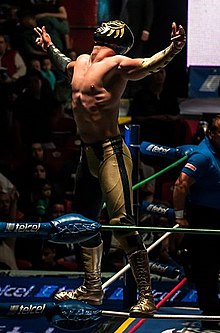Oro (wrestler)
| Oro | |
|---|---|
 Hernández wearing his trademark wrestling mask | |
| Birth name | Jesús Javier Hernández Silva |
| Born | December 24, 1971[1] Guadalajara, Jalisco, Mexico[1] |
| Died | October 26, 1993 (aged 21) Mexico City, Mexico |
| Professional wrestling career | |
| Ring name(s) |
|
| Billed height | 1.77 m (5 ft 9+1⁄2 in)[1] |
| Billed weight | 88 kg (194 lb)[1] |
| Trained by |
|
| Debut | November 23, 1990[1] |
Jesús Javier Hernández Silva (December 24, 1971 – October 26, 1993) was a Mexican professional wrestler known under the
Personal life
Born in
Professional wrestling career
The two brothers made their professional wrestling debut on November 23, 1990. Jesús Javier, at the age of 18, worked under the
As Oro moved away from Los Metalicos EMLL replaced him with Bronce (Bronze), a wrestling character patterned on Oro's image, but using bronze instead of gold. EMLL put Oro in a storyline feud with veteran wrestler Mano Negra (The Black Hand). On May 23, 1993, Oro defeated Mano Negra to win the NWA World Middleweight Championship.[6] This was the only singles title Oro won during his career. Mano Negra regained the title three weeks later, on July 3.[6] Originally, EMLL planned was to escalate the storyline, ending with the two wrestlers meeting in a Luchas de Apuestas ("Bet Match") where both wrestlers would wager their mask on the outcome. At the time however, Oro expressed a desire to spend more time with his family and travel less, wanting to retire no later than 1994; as a result, EMLL replaced Oro with Atlantis in the storyline.[7][8]
Death and memorial

On October 26, 1993, Oro teamed up with
Each year, around the anniversary of Jesús Javier Hernández Silva's death, the Lucha Libre community organizes a religious mass in memory of Jesús Hernández as well as other major names in Lucha Libre that have died in the previous year. The mass takes place in Arena Coliseo, the arena where Oro died.[12] A number of wrestlers have cited Oro as their inspiration for becoming a wrestler or an inspiration for them adopting a faster, more high-flying, high-risk style by the work he did in the ring.[12][13]
Oro in Lucha Libre
Jesús Javier Hernández was such a popular wrestler and in-ring character that the name has been used by a number of other wrestlers over the years.[14]
- Oro II, his brother Ismael Hernández Silva who worked as under the ring name Plata before Oro's death, changed his name in honor of his brother. Only used the name until 1995.[14]
- Oro II (Second version), Ismael Hernández Islas, another brother who adopted the name and mask in 1995.[14]
- Orito, a Mini-Estrella version of Oro that was active before Oro's death.[14]
- Oro Jr. (I), Orito moved to the regular sized division and changed his name.[14]
- Oro Jr., son of Ismael Hernández Solís, nephew of the original Oro. Began working for CMLL in late 2011.[14]
The Hernández wrestling family
The Hernández family has been in the professional wrestling business for three generations, starting with the brothers collectively known as Los Hermanos Calavera ("The Skull Brothers"), their six sons and one grandson who either are or has been professional wrestlers.[3][14]
| Father | |||||||||||||||||||||||||||||||||||||||||||||||||||||
| Hermano Calavera II | Hermano Calavera I | ||||||||||||||||||||||||||||||||||||||||||||||||||||
| Oro | Bronce II | Golden | |||||||||||||||||||||||||||||||||||||||||||||||||||
Oro, Jr. | |||||||||||||||||||||||||||||||||||||||||||||||||||||
Championships and accomplishments
- Consejo Mundial de Lucha Libre
- Comisión de Box y Lucha Libre Mexico Distrito Federal
- Distrito Federal Trios Championship (1 time) – with Plata and Platino[5]
- Pro Wrestling Illustrated
- PWI ranked him # 249 of the 500 best singles wrestlers during the PWI Years in 2003.
See also
References
- ^ a b c d e f g h i j k l m n "Enciclopedia de las Mascaras". Oro (in Spanish). Mexico City, Mexico. December 2007. p. 27. Tomo V.
- ISBN 978-0-06-085583-3.
- ^ ISBN 978-0-06-085583-3.
- ^ ISBN 0-9698161-5-4.
- ^ ISBN 0-9698161-5-4.
- ^ ISBN 0-9698161-5-4.
- ^ "Enciclopedia de las Mascaras". Mano Negra (in Spanish). Mexico City, Mexico. October 2007. p. 20. Tomo III.
- ^ "Lucha Libre: Conoce la historia de las leyendas de cuadrilátero". Atlantis (1962) (in Spanish). Mexico. 2008. p. 8. Grandes Figuras de la Lucha Libre.
- ISBN 978-0-06-085583-3.
- ISBN 0-9698161-5-4.
- ISBN 0-9698161-5-4.
- ^ a b "Misa De Oro Viernes 26 De Octubre". Fuego en el Ring (in Spanish). October 26, 2012. Retrieved October 27, 2012.
- ^ "Misa De Oro Viernes 26 De Octubre-26 de octubre, en la Arena coliseo" (in Spanish). Consejo Mundial de Lucha Libre Gaceta. October 25, 2012. Retrieved October 27, 2012.
- ^ a b c d e f g "¡Oro: 19 años sin brillar...!". Súper Luchas (in Spanish). October 26, 2012. Retrieved October 27, 2012.
